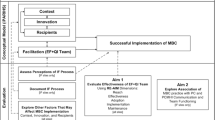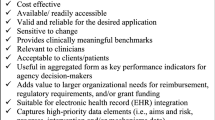Abstract
Two models for improving quality of care have been adopted by segments of the US mental healthcare system. Measurement-based quality improvement (MBQI) is routinely conducted by many provider organizations (including practices, hospitals and health plans), either at their own initiative or at the behest of payers and oversight organizations. Systematic implementation of evidence-based practices (EBPs) is being undertaken by several state mental health authorities and by other systems of care, working in collaboration with services researchers and stakeholders. Although they are distinct approaches, MBQI and EBP implementation (EBPI) overlap in their objectives and means. This article explores the degree to which these two approaches are aligned and whether further coordination between them could yield greater effectiveness or efficiency.



Similar content being viewed by others
References
Aarons, G. A., (2004). Mental health provider attitudes toward adoption of evidence-based practice: The evidence-based practice attitude scale (EBPAS). Mental Health Services Research, 6, 61–74.
Agency for Healthcare Research and Quality (2006). National guideline clearinghouse. Washington, DC: AHRQ.
APA Task Force on Quality Indicators (2002). Quality indicators. Defining and measuring quality in psychiatric care for adults and children. Washington, DC: American Psychiatric Association.
Berwick, D. M. (1989). Continuous improvement as an ideal in health care. New England Journal of Medicine, 320, 53–56.
Berwick, D. M., (2002). A user’s manual for the IOM’s ‘quality chasm’ report. Health Affairs 21, 80–90.
Blumenthal, D. & Kilo, C. (1998). A report card on continuous quality improvement. The Milbank Quarterly, 76, 625–648.
Brown, J., Shye, D., McFarland, B. et al. (2000). Controlled trials of CQI and academic detailing to implement a clinical practice guideline for depression. Joint Commission Journal on Quality Improvement, 26, 39–54.
Drake, R. E., Goldman, H. H., Leff, H. S. et al. (2001). Implementing evidence-based practices in routine mental health service settings. Psychiatric Services, 52, 179–182.
Druss, B. G. (2004). A review of HEDIS measures and performance for mental disorders. Managed Care, 13, 48–51.
Gardner, D. M., Baldessarini, R. J., & Waraich P. (2005). Modern antipsychotic drugs: A critical overview. CMAJ, 172, 1703–1711.
Goldberg, H. I., Wagner, E. H., Fihn, S. D. et al. (1998). A randomized controlled trial of CQI teams and academic detailing: Can they alter compliance with guidelines? Joint Commission Journal of Quality Improvement, 24, 130–142.
Hermann, R. C. (2005a). Improving mental healthcare: A guide to measurement-based quality improvement (pp. 6–25). Washington, DC: American Psychiatric Press, Inc.
Hermann, R. C. (2005b). Improving mental healthcare: A guide to measurement-based quality improvement. Washington, DC: American Psychiatric Press, Inc.
Hermann, R. C., Leff, H. S., Palmer, R. H. et al. (2000) Quality measures for mental health care: Results from a national inventory. Medical Care Research and Review, 57, 135–154.
Hermann, R. C. & Palmer, R. H. (2002) Common ground: A framework for selecting core quality measures. Psychiatric Services, 53, 281–287.
Hermann, R. C., Palmer, R. H., Leff, H. S. et al. (2004). Achieving consensus across diverse stakeholders on quality measures for mental healthcare. Medical Care, 42, 1246–1253.
Implementing Evidence-based Practices Project (2006). Evidence-based Practices: Shaping Mental Health Services Toward Recovery. Available at: http://www.mentalhealthpractices.org/index.html . Accessed May, 2006.
Institute of Medicine (2001a). Crossing the quality chasm: A new health system for the 21st century. Washington, DC: National Academy Press.
Institute of Medicine (2001b). Envisioning the national health care quality report. Washington, DC: National Academy Press.
Jamtvedt, G., Young, J. M., Kristoffersen, D. T., et al. (2003). Audit and feedback: effects on professional practice and health care outcomes. Cochrane Database System Review.
Jerrell, J. M. & Ridgely, M. S. (1999). Impact of robustness of program implementation on outcomes of clients in dual diagnosis programs. Psychiatric Services, 50, 109–112.
Joint Commission on the Accreditation of Health Care Organizations (2006). Hospital-Based, Inpatient Psychiatric Services Candidate Core Measure Set. Joint Commission on the Accreditation of Health Care Organizations. Available at: http://www.jointcommission.org/PerformanceMeasurement/PerformanceMeasurement/Hospital+Based+Inpatient+Psychiatric+Services.htm. Accessed March, 2006.
Juran, J. M. (1988). Juran on planning for quality. New York, NY: Free Press.
Kiefe, C., Allison, J., Williams, O. et al. (2001). Improving quality improvement using achievable benchmarks for physician feedback: A randomized controlled trial. Journal of the American Medical Association, 285, 2871–2879.
Lammers J.C., Creiten S., Gilman S. et al. (1996). Total quality management in hospitals: The contributions of commitment, quality councils, teams, budgets, and training to perceived improvement at veterans health Administration Hospitals. Medical Care, 34, 463–478.
Lehman, A. F., Goldman H. H., Dixon, L. B. et al. (2004). Evidence-based mental health treatments and services: Examples to inform public policy. New York, NY: Milbank Memorial Fund.
Lehman, W. E. K., Greener, J. M., & Simpson, D. D. (2002). Assessing organizational readiness for change. Journal of Substance Abuse Treatment, 22, 197–209.
Lieberman, J. A., Stroup, T. S., McEvoy, J. P. et al.(2005). Effectiveness of antipsychotic drugs in patients with chronic schizophrenia. New England Journal of Medicine, 353, 1209–1223.
McDonnell J., Nofs D., Hardman M. et al.(1989). An analysis of the procedural components of supported employment programs associated with employment outcomes. Journal of Applied Behavior Analysis, 22, 417–428.
McGovern M. P., Fox T. S., Xie H. et al. (2004). A survey of clinical practices and readiness to adopt evidence-based practices: Dissemination research in an addiction treatment system. Journal of Substance Abuse Treatment, 26, 305–312.
McHugo, G., Drake, R., Teague, G. et al. (1999). Fidelity to assertive community treatment and client outcomes in the New Hampshire dual disorders study. Psychiatric Services, 50, 818–824.
Mittman B., Hilborne L., & Brook R. (1994). Developing quality and utilization review criteria from clinical practice guidelines: Overview of the RAND method. RAND, Los Angeles, CA.
NASMHPD Research Institute (2005). Behavioral healthcare performance measurement system: List of measures. NASMHPD Research Institute, Inc. (NRI), Alexandria, VA.
National Association of State Mental Health Program Directors Research Institute (2006a). NRI performance measurement system national public rates: elopement rate (2003–2005). NRI, Alexandria, Virginia.
National Association of State Mental Health Program Directors Research Institute (2006b). NRI performance measurement system national public rates: medication error rate (2003–2005). Alexandria, Virginia: NRI.
National Committee for Quality Assurance (2005). Health plan employer data and information set (HEDIS) 2006. Washington, DC: National Committee for Quality Assurance (NCQA).
Palmer, R. & Banks, N. (1995). Designing and testing medical review criteria and performance measures in using clinical practice guidelines to evaluate quality of care volume 2: methods. Edited by AHCPR. Rockville, MD: US Department of Health and Human Services, US Public Health Service, Agency for Health Care Policy and Research, 1995.
Parker, V. A., Wubbenhorst, W. H., Young, G. J. et al (1999). Implementing quality improvement in hospitals: The role of leadership and culture. American Journal of Medical Quality, 14, 64–69.
Pellegrin, K. L, Carek, D., & Edwards, J. (1995). Use of experimental and quasi-experimental methods for data-based decisions in QI. Joint Commision Journal of Quality Improvement, 21, 683–691.
President’s Advisory Commission on Consumer Protection and Quality in the Health Care Industry (1998). Quality first: Better health care for all americans final report of the president’s advisory commission on consumer protection and quality in the health care industry. Washington, DC: US Government Printing Office.
Rees, H., Sipos, A., Harrison, S. M. (2002). Attitudes of psychiatrists to evidence-based guidelines: A questionnaire survey. Psychiatric Bulletin 2002: 421–424.
Rogers, E. M. (2003) Diffusion of innovations. The Free Press, New York.
Rosenthal, M. B., Fernandopulle, R., Song, H. R. et al. (2004). Paying for quality: Providers’ incentives for quality improvement. Health Affairs, 23, 127–41.
Rubenstein, L. V., Parker, L. E., Meredith, L. S. et al. (2002). Understanding team-based quality improvement for depression in primary care. Health Services Research, 37, 1009–1029.
Shortell, S. M., Benett, C. L., & Byck, G. R. (1998). Assessing the impact of continuous quality improvement on clinical practice: What will it take to accelerate progress. Milbank Quarterly, 76, 593–624.
Shortell, S. M., Levin, D. Z., O’Brien, J. L. et al. (1995). Assessing the evidence of CQI: Is the glass half empty or half full? Hospital and Health Services Administration, 40, 4–24.
Shortell, S.M., O’Brien, J.L., Carman, J.M. et al (1995). Assessing the impact of continuous quality improvement/total quality management: concept versus implementation. Health Services Research, 30, 377–401.
Shortell, S., Zazzali, J., Dubbs, N. (1999). National hospital quality improvement survey. Knowledge leadership series. Issue 3. Chicago: Arthur Andersen LLP and the American Hospital Association.
Soumerai, S. B., McLaughlin, T. J., Gurwitz, J. H. et al. (1998). Effect of local medical opinion leaders on quality of care for acute myocardial infarction: A randomized controlled trial. Journal of the American Medical Association, 279, 1358–1363.
Substance Abuse and Mental Health Services Administration. (2006a). US Department of Health and Human Services, National Outcome Measures (NOMs), vol. 2006, Rockville, MD: SAMHSA.
Substance Abuse Administration Mental Health Services. (2006b). Evidence-based practices: Shaping mental Health services toward recovery, Rockville, MD: SAMHSA.
The President’s New Freedom Commission on Mental Health (2003). Achieving the promise: Transforming mental Health care in america. final report. Washington, DC: Department of Health and Human Services.
Torrey, W. C., Finnerty, M., Evans, A. et al. (2003). Strategies for leading the implementation of evidence-based practices. Psychiatric Clinics of North America 26: 883–897, viii–ix.
US Department of Health and Human Services (1999). Mental health: A report of the surgeon general. Rockville, MD: US Department of Health and Human Services, Substance Abuse and Mental Health Services Administration, Center for Mental Health Services, National Institutes of Health, National Institute of Mental Health.
Valenstein M., Mitchinson A., Ronis D. L. et al. (2004). Quality indicators and monitoring of mental health services: What do frontline providers think? American Journal of Psychiatry, 161, 146–153.
Zaltman, G., Duncan, R., & Holbek, J. (1984). Innovations and organizations. Robert E. Krieger: Malabar, FL.
Author information
Authors and Affiliations
Corresponding author
Additional information
Supported by National Institute of Mental Health grant R34-MH074788.
Rights and permissions
About this article
Cite this article
Hermann, R.C., Chan, J.A., Zazzali, J.L. et al. Aligning Measurement-based Quality Improvement with Implementation of Evidence-based Practices. Adm Policy Ment Health 33, 636–645 (2006). https://doi.org/10.1007/s10488-006-0055-1
Published:
Issue Date:
DOI: https://doi.org/10.1007/s10488-006-0055-1




